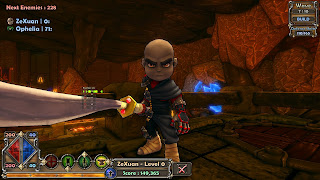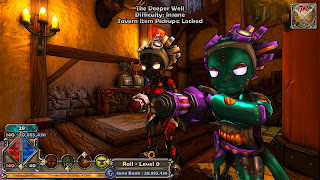Last week I explained how Nintendo had done something
amazing with the character of Samus Aran by portraying her of as a woman of
action and determination. Her fans have known her for twenty years as a
no-nonsense bounty hunter – the best hunter in the galaxy we were told. From
1987 to 2010, the Samus we grew to know was fearless in the face of exotic and
haunting locales filled with all manners of hostile creatures. Her long-term
fans thought she was capable of anything the universe could throw at her. Then
in 2010, the producers at Nintendo decided Samus needed to be redefined so
players could relate to her humanity more and so they created Metroid: Other M which the title implies
is not your average “Metroid” title. In fact, as far as the character of Samus
Aran is involved, it’s far from it.
Now I have to point out that Metroid: Other M is not a terrible game if all you are concerned with is music and gameplay. It can be fun and it does a good job of keeping the general dark tone of the “Metroid” series as you are fighting your way through the Bottle Ship. The exploration which marked the “Metroid” series was stripped down in order to facilitate the comprehensive story they are attempting to tell, and that required a much more linear track to follow than most other games in the series. That’s really all the nice words I can say for this game, because the story destroys the rest of it. It’s difficult for me to even begin to describe how much the story of Metroid: Other M is abysmal compared to all other entries in the franchise.
The “Metroid” games are typically void of narration or
exposition to force plot on you. The original trilogy (Metroid, Metroid II: Return
of Samus, Super Metroid) gave you
some back story in the player’s manual, or opening sequence, and then just left
you to your own devices to work your way through the labyrinthine corridors of
Zebes and SR388. The “Prime” trilogy (Metroid
Prime, Metroid Prime 2: Echoes, Metroid Prime 3: Corruption) allowed you
to scan points with your visor to pick up pieces of the story like well hidden
clues. It was there for you to explore, or ignore, as you pleased. Keep in mind
that these stories were only more information about the current mission or
present situation, it did little to explain Samus as a person or delve into her
background. That type of story was never necessary, but it certainly wouldn’t
have been something undesirable. There were two games before Metroid: Other M that did attempt to put
a bit more narrative and plot into a game driven by exploration, and our long
silent protagonist actually found herself with some lines of dialogue, but
these two games didn’t undermine her core personality. She remained resolved
and determined as any previous incarnation. Those two games are Metroid Fusion and the retelling of the
original Metroid story Metroid: Zero Mission.
As a story lover, I was excited to hear they were building a
“Metroid” game that was driven by a narrative. I was interested to hear Samus
speak for the first time. I think filling in the blanks of Samus as a person is
a great idea and could have led to a fascinating game about her past and her
personality, but unfortunately what we got in Metroid: Other M can only be described as a tragedy. It took those
great ideas and created a character whose personality is the most
one-dimensional I can possibly imagine. It’s as if the game is saying to me,
“Samus is a woman. She leads one-woman genocides against the most dangerous and
terrifying, life-draining aliens in the universe, but don’t forget: she is
still a woman. Over the next few hours, let us reinforce that description in
the most stereotypical way possible.” Here’s a brief list of fundamental changes
they made to Samus’s core character in Metroid:
Other M.
- Samus now obsessively refers to the Metroid hatchling who saved her life as “the baby”
- Samus now has daddy issues when confronting her former CO, Adam Malkovich.
- Adam calls her “Lady” (established previously in Metroid Fusion)
- Her former teammates call her “Princess.”
- She freezes up in shock or fear when faced with a particular recurring enemy, Ridley
- Although she is replying to an open distress call, she submits to Adam’s authority.
- Sector Zero (the Metroid storage sector) is destroyed by Adam.
- MB (final boss) is ultimately defeated by the Space Marines.
 |
| Am I authorized to shoot that thing? I better ask Adam. |
Over the course of the game, I’m forced to watch cutscene
after cutscene of self-doubt and flashbacks of Samus’s rebellious teen years
where she boldly gives her CO, Adam Malkovich, the “thumbs down” instead of a
“thumbs up” during mission briefings. It’s not easy to sit there and watch her take
orders from a father figure through some sense of repressed, misguided loyalty.
It’s unbearable to watch her freeze up
in the face of danger and watch as an ally presumably falls to his death in an attempt to protect her. It all seems like a coming of age story being told
through the words of a teenager’s diary, but instead I’m expected to believe
these are Samus’s current thoughts and fears as she’s fighting her way through
yet another Metroid infested space scenario. This would all make sense in
context if it took place much earlier, before she was the best bounty hunter in
the galaxy. Instead, you are forced to watch a narrative destroy what you know
and love about a character piece by piece in scenes you wish you could skip,
but cannot.
 |
| This is how Samus fans rate "Other M." |
 |
| It's not what you do that defines you, but that you're a woman underneath. |
I want to finish my illustration of this deviation in Samus's character by embedding a video for the first time on TOP Gaming. I want to compare and contrast Samus fighting the Space Pirate leader, Ridley, the last two chronological times - Super Metroid and Metroid: Other M.
Samus runs into a room. Ridley appears. Fighting ensues. No one tells her which weapons to use. She doesn't have flashbacks of herself as a child. There's no 15 minute monologue about her feelings. The enemy stands before her and they fight. You may want to take note that her Chozo battle suit stays on the entire fight, because she'll probably need it for protection.
If you watched this video you may notice a few things. First, Adam has to tell her to use Super Missiles and Plasma Beam. I assume if he didn't, Samus would just die at the end of this scene, but fortunately daddy knows how to fight Ridley. You're then subjected to the infamous Samus "freeze up" scene where she flashbacks to herself as a child with Ridley screeching over her (in a real show of compassion from Ridley). Then he gets tired of her flashback and grabs her King Kong style and flies around the room menacingly. Samus struggles to act still and her suit dematerializes. It reveals her to be the damsel in distress she is turning into for this scene. Fortunately there's a strong man in the room to save her. Anthony draws Ridley's attention and for his efforts is treated to a nice lava bath while Samus sits there and watches. Finally she decides to get up and fight. The contrast between these two scenes speaks volumes to how this Samus in Metroid: Other M is not only inferior, but completely unbelievable compared to her previous incarnations.
 |
| All women need a big, strong, powerful man to watch their six. |
When I played this game in 2010, I was prompted to write a
short eulogy for Samus Aran because I felt the character I had known, loved and
respected had died when I thought this was how her creators imagined her all
those years ago. Looking forward, however, I can hope that they would learn
from their mistakes. I realize that
she is not exactly dead and going forward the developers have two choices. They
return the Samus of old to us, or they continue to expand on the woman beneath
the power suit. Perhaps the now that her daddy issues are resolved, she can
spend “Other M 2” looking for a husband or trying to fill the hole in her heart
that the baby Metroid left. If they choose the latter, I won’t be buying any
more games in my favorite adventure/exploration series, but I now retain some
hope that the former woman of action will return someday. In the meantime, I don't have to mourn her or miss her because the Samus I always loved is available in Super Metroid and every other great title the "Metroid" series has seen in the last twenty five years.
-TOP
Related Links
My original 2010 pseudo-eulogy "The Death of Samus Aran"
G4 Game Review of Metroid: Other M
"Killing Samus" IGN Article
"The Psychology of Samus and the Roles of Adam and Ridley"
-TOP
Related Links
My original 2010 pseudo-eulogy "The Death of Samus Aran"
G4 Game Review of Metroid: Other M
"Killing Samus" IGN Article
"The Psychology of Samus and the Roles of Adam and Ridley"


















